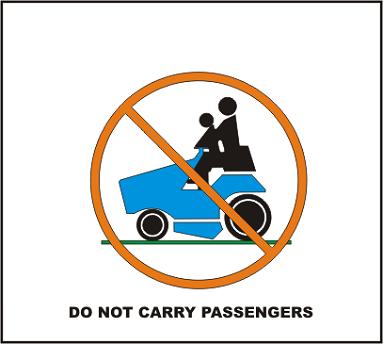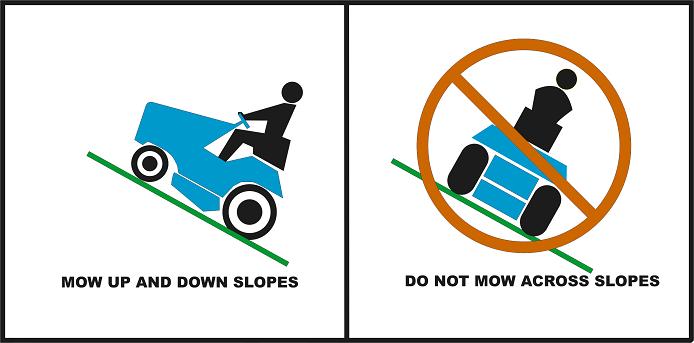Riding Lawnmowers
Consumer Product Safety Commission
Riding Lawnmowers
Document #588
While homeowners generally use walk-behind power lawnmowers to cut small plots of grass, many residents with large lawns have come to rely on riding mowers, lawn tractors, and garden tractors as indispensable machines for maintaining the landscape. Zero turn radius mowers are now available at many retail power equipment outlets. A zero turn radius mower can rotate 180 degrees and move away on the same path that it came in on. This enables homeowners to mow close to landscaping and buildings. Aside from cutting large areas of grass, some machines also accommodate a host of attachments to make quick work of otherwise cumbersome garden projects.
Hazards most often associated with riding equipment are blade contact and loss of stability. The U.S. Consumer Product Safety Commission estimates that 37,000 consumer injuries related to riding mower incidents were treated annually in hospital emergency rooms during 2003-2005. Based on incidents reported to the Commission, an annual average of 95 deaths was attributed to riding mowers during 2001-2003. Fatal incidents have several common patterns: the machine tips over, the victim falls under or is run over by the machine (incidents involving young children are in this category), or the victim is thrown from or falls off the machine.
The voluntary safety standard for walk-behind and ride-on mowers is ANSI/OPEI B71.1-2003.If you are shopping for a new mower, a label certifying that the mower or garden tractor meets the 2003 ANSI B71.1 standard indicates that the machine has these safety features.
- Operator presence control. This safety device will stop the rotary blades if the operator leaves the control position of the riding mower without first disengaging the blade drive. This feature will reduce the chance of injury if the operator leaves the control position to perform some other activity without first stopping the mower blade(s).
- Increased seatback height. Look for seatbacks of at least 4 1/2 inches to help the operator maintain a safe position on the machine.
- Dynamic turn and sudden traction performance limits have been added to improve machine stability.
- In 2003 a requirement was added that prevents the mower from backing up with powered blades. This feature can reduce the severity of injuries that are caused when an operator backs into a young child by stopping the rotating blades. The standard permits a device that overrides this no mow in reverse feature temporarily. If an override capability is provided, it shall automatically reset when one or more of the following actions occurs: (1) the blade is re-engaged or (2) the engine is restarted or (3) the directional control is moved from reverse. Ride-on machines with zero turn radius capability and machines with front mount mowers are excluded from the requirement.
SAFE OPERATING PRACTICES FOR RIDE-ON MOWERS1
I. GENERAL OPERATION
This cutting machine is capable of amputating hands and feet and throwing objects. Failure to observe the following safety instructions could result in serious injury or death to the operator and/or bystander.
- Read, understand, and follow all instructions on the machine and in the manual(s) before starting.
- Do not put hands or feet near rotating parts or under the machine. Keep clear of the discharge opening at all times.
- Only allow responsible adults, who are familiar with the instructions, to operate this machine.
- Clear the area of objects such as rocks, wire, toys, etc., which could be thrown by the blade(s).
- Be sure the area is clear of bystanders before operating. Stop the machine if anyone enters the area.
- Never carry passengers.
- Do not mow in reverse unless absolutely necessary. Always look down and behind before and while backing.
- Never direct discharged material toward anyone. Avoid discharging material against a wall or obstruction. Material may ricochet back toward the operator. Stop the blades(s) when crossing gravel surfaces.
- Do not operate machine without the entire grass catcher, discharge guard, or other safety devices in place and working.
- Slow down before turning.
- Never leave a running machine unattended. Always turn off the blade(s), set the parking brake, stop the engine, and remove the key before dismounting.
- Disengage blade(s) when not mowing. Shut off engine and wait for all parts to come to a complete stop before cleaning the machine, removing the grass catcher, or unclogging the discharge guard.
- Operate machine only in daylight or good artificial light.
- Do not operate the machine while under the influence of alcohol or drugs.
- Watch for traffic when operating near or crossing roadways.
- Use extra care when loading or unloading the machine into a trailer or truck.
- Always wear eye protection when operating machine.
- Follow the manufacturer’s recommendation for wheel weights or counterweights.
1American National Standards Institute ("ANSI"). Reproduced with permission of ANSI on behalf of the Outdoor Power Equipment Institute (OPEI) from ANSI B71.1-2003, Walk-Behind Mowers and Ride-On Machines with Mowers - Safety Specifications, 60 Safe Practices for Ride-On Mowers, pp.62-65. No further reproduction is authorized. For more information about OPEI, please go to www.opei.org. A complete copy of ANSI B71.1-2003 is available for purchase from ANSI at http://webstore.ansi.org/ansidocstore/dept.asp?dept_id=3100.
II. SLOPE OPERATION
Slopes are a major factor related to loss of control and tip-over accidents, which can result in severe injury or death. Operation on all slopes requires extra caution. If you cannot back up the slope or if you feel uneasy on it, do not mow on it.
- Mow up and down slopes, not across.
- Watch for holes, ruts, bumps, rocks, or other hidden objects. Uneven terrain could overturn the machine. Tall grass can hide obstacles.
- Choose a low ground speed so you will not have to stop or shift while on a slope.
- Do not mow on wet grass. Tires may lose traction.
- Always keep the machine in gear when going down slopes. Do not shift to neutral and coast downhill.
- Avoid starting, stopping, or turning on a slope. If the tires lose traction, disengage the blade(s) and proceed slowly straight down the slope.
- Keep all movement on slopes slow and gradual. Do not make sudden changes in speed or direction, which could cause the machine to roll over.
- Use extra care while operating the machine with grass catchers or other attachments; they can affect the stability of the machine. Do not use on steep slopes.
- Do not try to stabilize the machine by putting your foot on the ground.
- Do not mow near drop-offs, ditches or embankments. The machine could suddenly roll over if a wheel goes over the edge or if the edge caves in.

Tragic accidents can occur if the operator is not alert to the presence of children. Children are often attracted to the machine and the mowing activity. Never assume that children will remain where you last saw them.
- Keep small children out of the mowing area, and in the watchful care of a responsible adult other than the operator.
- Be alert and turn machine off if a child enters the area.
- Before and while backing, look behind and down for small children.
- Never carry children, even with the blade(s) shut off. They may fall off and be seriously injured or interfere with safe mower operation. Children who have been given rides in the past may suddenly appear in the mowing area for another ride and be run over or backed over by the machine.
- Never allow children to operate the machine.
- Use extreme care when approaching blind corners, shrubs, and trees, or other objects that may block your view of a child.
IV. TOWING
- Tow only with a machine that has a hitch designed for towing. Do not attach towed equipment except at the hitch point.
- Follow the manufacturer’s recommendation for weight limits for towed equipment and towing on slopes.
- Never allow children or others in or on towed equipment.
- On slopes, the weight of the towed equipment may cause loss of traction and loss of control.
- Travel slowly and allow extra distance to stop.
V. SERVICE
SAFE HANDLING OF GASOLINE:
To avoid personal injury or property damage, use extreme care in handling gasoline. Gasoline is extremely flammable and the vapors are explosive.
- Extinguish all cigarettes, cigars, pipes, and other sources of ignition.
- Use only an approved gasoline container.
- Never remove gas cap or add fuel with the engine running. Allow engine to cool before refueling.
- Never fuel the machine indoors.
- Never store the machine or fuel container where there is an open flame, spark, or pilot light such as on a water heater or other appliances.
- Never fill containers inside a vehicle or on a truck or trailer bed with a plastic liner. Always place containers on the ground away from your vehicle before filling.
- Remove gas-powered equipment from the truck or trailer and refuel it on the ground. If this is not possible, then refuel such equipment with a portable container, rather than from a gasoline dispenser nozzle.
- Keep the nozzle in contact with the rim of the fuel tank or container opening at all times until the fueling is complete. Do not use a nozzle lock-open device.
- If fuel is spilled on clothing, change clothing immediately.
- Never overfill fuel tank. Replace gas cap and tighten securely.
GENERAL SERVICE
- Never operate machine in a closed area.
- Keep all nuts and bolts tight to be sure the equipment is in safe working condition.
- Never tamper with safety devices. Check their proper operation regularly.
- Keep machine free of grass, leaves, or other debris build-up. Clean up oil or fuel spillage and remove any fuel-soaked debris. Allow machine to cool before storing.
- If you strike a foreign object, stop and inspect the machine. Repair, if necessary, before restarting.
- Never make any adjustments or repairs with the engine running.
- Check grass catcher components and the discharge guard frequently and replace with manufacturer’s recommended parts, when necessary.
- Mower blades are sharp. Wrap the blade or wear gloves, and use extra caution when servicing them.
- Check brake operation frequently. Adjust and service as required.
- Maintain or replace safety and instruction labels, as necessary.
032007


